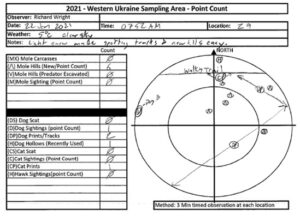User: | Open Learning Faculty Member:
Previously I had been gathering raw data on mole hill activity and predator signs in a 1km x 1km area in western Ukraine. This area was divided into zones each with distinct boundaries and each with a mole colony. The northern half of the area has increased feral canine and stray cat activity.
The intent is to use the data to determine its effect on my null hypothesis, “The number of predators in a given area does not affect the activity of mole colonies in the same area.”
Initially I was using a haphazard sampling technique but had to refine it in order to capture moving pr

edators. The original sampling technique worked well to capture mole activity via the count of new mounds, but failed to be consistent in how predators were recorded. The initial counts were also difficult to conduct because of the duration I was spending at each of the approx. 12 zones. This took most of the morning each day since I was gathering a large amount of spacial data. The time expenditure was significant. There was additional difficulty as I needed to gather data along a chronological gradient. Since the activity of the predators appeared to ebb and flow I also realized that this would need more than a single day of data gathering to do a comparison.
I wanted to capture statistically relevant data, so that I could determine if there was a correlation between these two data points. My solution was to pivot and use a point count with a 3 minute waiting period before moving on to the next location on the route.
This method would be more beneficial as the time frame would give me an opportunity to not only be consiste

nt in the time of recordings, but also expedite my data collection.
After doing this I graphed some of my data and was surprised that there may (initially) be a correlation between canine predator activity and mole hill activity.
Continuing forward, I will collect data using the point count system. My hope is to do a week or two of data collection each morning to capture both the fluctuations in mole and predator activity. This alteration in data collection should improve consistent precision in my data gathering while reducing time spent.
I am looking forward to collating all of the data and seeing the results.
